Archived Content
Information identified as archived on the Web is for reference, research or recordkeeping purposes. It has not been altered or updated after the date of archiving. Web pages that are archived on the Web are not subject to the Government of Canada Web Standards. As per the Communications Policy of the Government of Canada, you can request alternate formats on the Contact Us page.
Armillaria Root Disease
Armillaria ostoyae (Romagnesi) Herink
(= Armillaria obscura Schaeff.:Fr.)
Basidiomycotina, Agaricales, Tricholomataceae
The term "Armillaria root disease" refers to a group of diseases caused by several related Armillaria species, sometimes known as the Armillaria root disease complex. In some older literature the name Armillaria mellea (Vahl:Fr) P. Kumm. was used in a broad sense for all species in the group. Recent research has clarified the taxonomy of the fungi involved, identifying those that are commonly found in B.C. In this treatment of Armillaria root disease, Armillaria ostoyae will be discussed separately from the other species found in the province as it has the greatest impact on the management of coniferous trees.
Armillaria ostoyae
Hosts: In B.C., Armillaria ostoyae has been reported on amabilis, grand, and subalpine fir, European, Japanese, and western larch, Engelmann, Norway, Sitka, and white spruce, lodgepole, western white, mugo, bishop, Austrian black, maritime, ponderosa, Monterey, red, and Scots pine, Douglas-fir, western redcedar, western hemlock, western yew, rocky mountain juniper, Port Orford cedar, and Oregon boxwood. Host records specifically for A. ostoyae in other parts of North America are not available, but in these areas as well as in B.C. the fungus is likely found on a wide range of broadleaved trees, shrubs, and herbaceous plants.
Distribution: Circumpolar in the northern hemisphere and 49° to approximately 52-53 °N in B.C.
Identification: On conifers, A. ostoyae causes crown symptoms typical of root diseases; that is, reduced leader growth and foliage discoloration and thinning (Fig. 1a). On trees where the fungus is present at the root collar, resin exudes through the bark of the lower bole (Fig. 1b). This symptom is most obvious on resinous tree species such as Douglas-fir and lodgepole pine, but rare on non-resinous species such as western redcedar. Among resinous species, it is more obvious on moist sites than dry sites. White mycelial fans occur in the bark and in the cambial zone under bark showing resinosus (Figs. 1c, 1d, 1e). On diseased trees and those that have been dead for several years, impressions of mycelial fans may be seen on the inner bark. In conifer stands, trees with cone-shaped basal lesions caused by A. ostoyae that have callus at the margin are common. On western redcedar, basal lesions are commonly covered with loose, dead bark and form a flattened face on the side of the tree bearing the lesion. Broadleaved trees and shrubs show reduced growth and sparse foliage before death, and red to brown foliage and mycelial fans at the base of the stem after death.
Dead and diseased trees usually occur in "disease centers," which appear as openings in the canopy, and may be as large as 0.1 ha in mature stands (Fig. 1f). However, in some stands, distinct centers are absent and diseased trees are scattered throughout the stand. In young plantations and natural stands, diseased trees occur around colonized stumps of the previous stand (Fig. 1g).
The fruiting bodies of A. ostoyae are cream to brown-coloured mushrooms with a 5-10 cm wide cap and a distinct ring on the stem (Figs. 1h, 1i). The mushrooms are produced from late summer to mid-autumn around the base of infected, living trees, killed trees, and colonized stumps. Fruiting bodies are also commonly growing from dead wood associated with scars on living trees.
The incipient decay of A. ostoyae in roots on coniferous and broadleaved trees is yellow to brown in colour with a watersoaked appearance (Fig. 1j). Later, the decayed wood becomes stringy, gelatinous, and very wet.
Damage: Armillaria ostoyae causes growth loss and small amounts of butt rot in diseased trees, however mortality is the greatest cause of loss. The fungus can kill conifers in plantations and natural stands throughout a rotation when roots of healthy trees grow into contact with, or form root grafts with the roots of diseased trees (Fig. 1k). On the coast, A. ostoyae is seldom serious in trees older than about 15 years whereas in the interior, trees of all ages are killed.
Remarks: On sites infested by A. ostoyae, there are currently two management strategies that can be applied at the time of harvest to reduce losses in the next rotation: 1) reduce the amount of inoculum by removing stumps (Fig. 1l), and 2) regenerate the site with one or more resistant or poor-host species.
References:
Morrison, D. J., D. Chu, and A. L. S. Johnson. 1985. Species of Armillaria in British Columbia. Can. J. Plant Pathol. 7:242-246.
Morrison, D. J., G. W. Wallis, and L. C. Weir. 1988. Control of Armillaria and Phellinus root diseases: 20-year results from the Skimikin stump removal experiment. Can. For. Serv., Rep. No. BC-X-302.
Morrison, D., H. Merler, and D. Norris. 1992. Detection, recognition, and the management of Armillaria and Phellinus root diseases in the southern interior of British Columbia. Can. For. Serv., B.C. Min. For., FRDA Rep. No. 179.
Shaw, C. G. III and G. A. Kile. 1991. Armillaria Root Disease. USDA For. Serv. Agric. Hdbk. No. 691.
Figures
Click on any image to see the full size version.
Press "Back" on your browser to return to this screen.

Figure 1a: Reduced leader growth and chlorotic foliage on Armillaria infected Douglas-fir.
 Figure 1b: Resinosus on the lower stem of an Armillaria infected tree.
Figure 1b: Resinosus on the lower stem of an Armillaria infected tree.
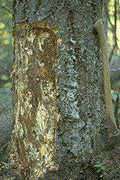 Figure 1c: Armillaria mycelial fans beneath bark of lower stem 1c.
Figure 1c: Armillaria mycelial fans beneath bark of lower stem 1c.
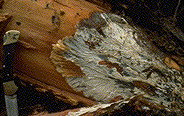 Figure 1d: Armillaria mycelial fans beneath bark of lower stem 1d.
Figure 1d: Armillaria mycelial fans beneath bark of lower stem 1d.
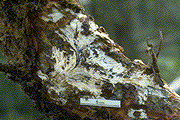 Figure 1e: Armillaria mycelial fans beneath bark of root 1e.
Figure 1e: Armillaria mycelial fans beneath bark of root 1e.
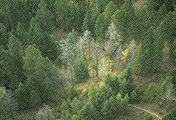 Figure 1f: Armillaria root disease center in a 80- to 100-year old Douglas-fir stand (30 years after partial cutting).
Figure 1f: Armillaria root disease center in a 80- to 100-year old Douglas-fir stand (30 years after partial cutting).
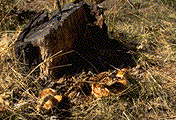 Figure 1g: Armillaria fruiting bodies around a diseased Douglas-fir stump.
Figure 1g: Armillaria fruiting bodies around a diseased Douglas-fir stump.
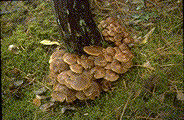 Figure 1h: Fruiting bodies of Armillaria ostoyae associated with Douglas-fir.
Figure 1h: Fruiting bodies of Armillaria ostoyae associated with Douglas-fir.
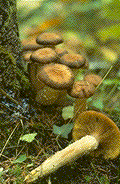 Figure 1i: Fruiting bodies of Armillaria ostoyae associated with western larch.
Figure 1i: Fruiting bodies of Armillaria ostoyae associated with western larch.
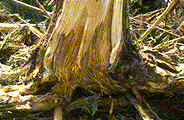 Figure 1j: Butt rot in Engelmann spruce.
Figure 1j: Butt rot in Engelmann spruce.
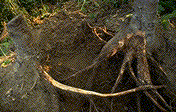 Figure 1k: Transfer of A. ostoyae from a colonized stump to a living tree in a spaced stand.
Figure 1k: Transfer of A. ostoyae from a colonized stump to a living tree in a spaced stand.
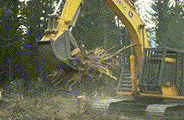 Figure 1l: Stump removal to reduce Armillaria inoculum.
Figure 1l: Stump removal to reduce Armillaria inoculum.
 This Web page has been archived on the Web.
This Web page has been archived on the Web.